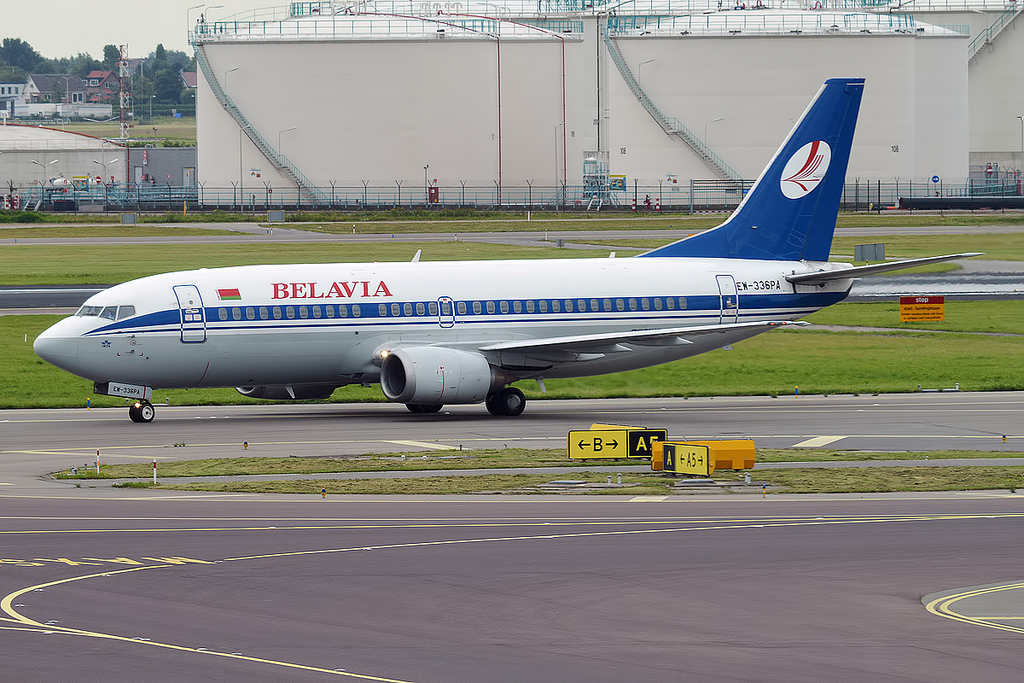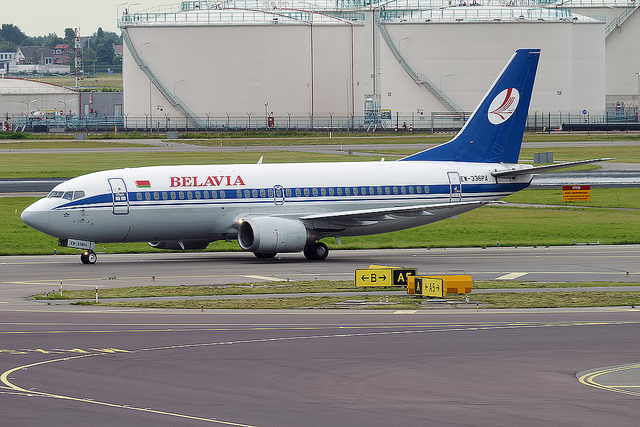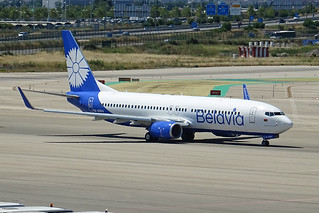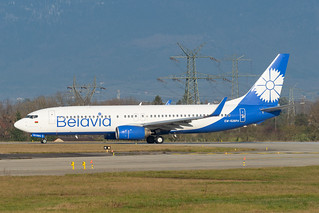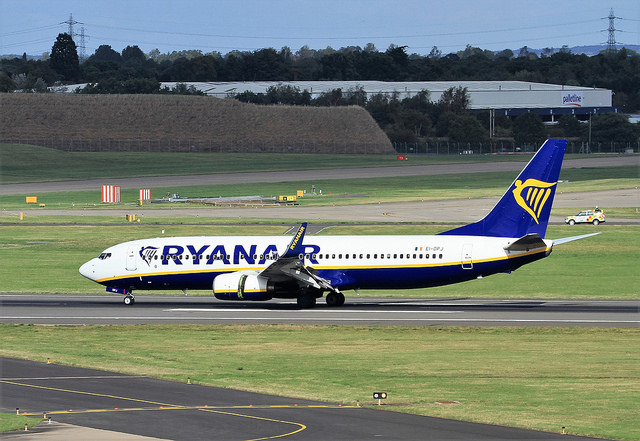Belavia B733 at Kiev on Jul 12th 2019, overran runway on landing
Last Update: March 20, 2020 / 21:24:07 GMT/Zulu time
Incident Facts
Date of incident
Jul 12, 2019
Classification
Incident
Airline
Belavia
Flight number
B2-847
Departure
Minsk, Belarus
Destination
Kiev Zhulyani, Ukraine
Aircraft Registration
EW-336PA
Aircraft Type
Boeing 737-300
ICAO Type Designator
B733
Airport ICAO Code
UKKK
The aerodrome was closed for about 16 hours until the aircraft was removed.
On Jul 17th 2019 Ukraine's NBAAI reported the aircraft went 86 meters past the end of paved surface (safety area past the runway end). There were no injuries, the aircraft received minor damage to its gear. The occurrence was rated a serious incident and is being investigated.
On Mar 20th 2020 the NBAAI released their final report in Ukrainian only (Editorial note: to serve the purpose of global prevention of the repeat of causes leading to an occurrence an additional timely release of all occurrence reports in the only world spanning aviation language English would be necessary, a Ukrainian only release does not achieve this purpose as set by ICAO annex 13 and just forces many aviators to waste much more time and effort each in trying to understand the circumstances leading to the occurrence. Aviators operating internationally are required to read/speak English besides their local language, investigators need to be able to read/write/speak English to communicate with their counterparts all around the globe).
The report concluded the cause of the serious incident was:
Touchdown of the aircraft about 970 meters past the displaced threshold runway 26 due to autothrust remaining engaged which caused the engines to increase thrust to maintain the selected speed, which after the crew increased the pitch angle to flare causing increased lift and a prolonged flare.
Contributing factors were:
- meteorlogic conditions
- hydroplaning as well as planing due to overheating rubber
- reversers were not used until full stop of the aircraft
Nearing Kiev the crew listened to ATIS and as result prepared and briefed for a landing on runway 08. During the descent towards Kiev the crew was informed by ATC, that the runway had been switched to 26 and a new ATIS was present. The crew listened to ATIS and briefed for a landing on runway 26. The aircraft positioned to intercept the localizer runway 26. During the intercept ATC reported the winds were from 310 degrees at 2 gusting 5 meters/second (4 to 9 knots), there was a rain shower on the aiefield, QNH 1009, the aircraft was cleared to land on runway 26 with the additional information that the runway was wet, 3mm of water on the runway, braking coefficient was 0.52 (braking action good). The landing distance required was computed at 4934 feet (1503 meters), the landing distance available was 7421 feet (2262 meters).
The crew extended flaps 30 (Vref=136 KIAS) and set the autobrakes to MAX. At 500 feet AGL the crew disconnected the autopilot, however, left autothrust engaged. The aircraft crossed the (displaced) runway threshold at 36 feet AGL and 141 KIAS (Vref+5). The crew increased the pitch angle to about 4.5-5 degrees in order to flare the aircraft, autothrottle however increased the engine thrust to maintain the target speed of 141 knots. At 20 feet AGL the vertical speed had reduced to 0 fpm. While flying parallel to the runway surface at 15 feet AGL for about 6-7 seconds the crew returned the thrust levers to idle, the airspeed began to reduce and the aircraft began to descend again. About 7 seconds after the thrust reduction the aircraft's main gear settled on the runway about 970 meters (3182 feet) past the displaced threshold of the runway at about 132 KIAS, +1.34G vertical acceleration. Due to 3mm water standing on the runway the main tyres immediately start hydroplaning. 2 seconds after the main gear the nose gear settled on the runway, spoilers deployed, the engines are selected into reverse and full reverse thrust is being used in addition to maximum braking.
When the crew sensed the autobrakes were insufficient to stop the aircraft, they applied manual braking. Slowing through 61 knots the thrust reversers were stowed, which resulted in a small forward thrust vector, which did not permit the aircraft to stop within the runway surface. The aircraft crossed the runway end about 4 meters to the left of the center line, continued across the paved surface of the runway end safety area, went onto soft ground and came to a stop 153 meters past the end of the runway, about 3 meters to the left of the extended runway center line.
The captain instructed the passengers to remain in their seats, informed tower about the runway excursion and requested emergency services to check the aircraft as well as a measurement of the braking action of the runway. About 20 minutes after the aircraft came to a stop the passenger disembarked via mobile stairs and were bussed to the terminal.
There were no injuries, the aircraft sustained minor damage.
The NBAAI analysed that the actual landing distance from touch down to stop was 1445 meters (4570 feet), less than the computed landing distance required. It can thus be concluded that the braking was quite effective, the runway condition as well as the braking by the aircraft were not a contributing factor to the serious incident.
While the autopilot was disengaged at 134 meters AGL autothrust remained engaged. According to the FCOM both autopilot and autothrust need to be disengaged at the latest when descending through the minimum height permitted for single channel autopilot operation.
As the autothrust had not been disengaged the engines were accelerated to maintain 141 KIAS when the crew attempted to flare the aircraft until the aircraft was floating parallel to the runway at 15 feet AGL for about 6-7 seconds. The captain did notice the aircraft was floating and pulled the thrust levers into idle. Both pilots believed the aircraft had landed in the touchdown area - the NBAAI analysed that this perceiption was probably due to the landing in heavy rain in night conditions with windscreen wipers not being turned on, which did not permit the captain to correctly determine the touch down zone. As the crew believed to have touched down within the touch down zone, they did not decide to balk the landing and go around.
When the captain felt, automatic braking was insufficient to stop the aircraft on the runway, he started to apply manual braking and informed the first officer, who in turn disengaged automatic braking. As result of these actions the brakes pressure actually decreased.
While the engines spooled up for reverse thrust at 77-78% N1 the brakes pressure began to increase again from about 1000 PSI to 2970 PSI.
When the thrust reversers were stowed again the aircraft was at 61 KIAS 282 meters before the end of the runway. The deceleration on thrust reverse had been normal and effective. When the thrust reversers went into the stowed the position the engines were still at about 60% N1, the aircraft thus received a considerable forward push by the engines until they reached 32% N1 about 6 seconds later. Had the thrust reverser not been stowed but left open until the aircraft had stopped, the aircraft would have stopped 214 meters later, hence within the runway boundaries.
The investigation computed the conditions for hydroplaning of the tyres and found, that the tyres would hydroplane at above 128 over ground. As the aircraft touched down at a ground speed of 138 knots, the conditions for hydroplaning were met.
Due to the spoilers extending the aircraft slowed from 138 to 126 knots over ground in about 4 seconds, the hydroplaning stopped by then. The crew however felt the aircraft was not declerating during that time and switched to manual braking, which effectively reduced the brakes pressure. In addition, after the hydroplaning ended and the manual brakes pressure increased again to 2970 PSI, the rubber of the tyres began to overheat and entered planing again due to overheat and decreased the effectivity of braking.
Related NOTAMs:
A2007/19 NOTAMN
Q) UKBV/QMRLC/IV/NBO/A /000/999/5024N03027E005
A) UKKK B) 1907130710 C) 1907130900
E) RWY 08/26 CLOSED.
A2008/19 NOTAMR A2007/19
Q) UKBV/QMRLC/IV/NBO/A /000/999/5024N03027E005
A) UKKK B) 1907130855 C) 1907131000
E) RWY 08/26 CLOSED.
A2010/19 NOTAMR A2009/19
Q) UKBV/QMRLC/IV/NBO/A /000/999/5024N03027E005
A) UKKK B) 1907131040 C) 1907131100
E) RWY 08/26 CLOSED.
A2009/19 NOTAMR A2008/19
Q) UKBV/QMRLC/IV/NBO/A /000/999/5024N03027E005
A) UKKK B) 1907130950 C) 1907131200
E) RWY 08/26 CLOSED.
A2003/19 NOTAMR A2002/19
Q) UKBV/QMRLC/IV/NBO/A /000/999/5024N03027E005
A) UKKK B) 1907130145 C) 1907130500
E) RWY 08/26 CLOSED.
A2002/19 NOTAMN
Q) UKBV/QMRLC/IV/NBO/A /000/999/5024N03027E005
A) UKKK B) 1907130010 C) 1907130200
E) RWY 08/26 CLOSED.
A2004/19 NOTAMR A2003/19
Q) UKBV/QMRLC/IV/NBO/A /000/999/5024N03027E005
A) UKKK B) 1907130420 C) 1907130600
E) RWY 08/26 CLOSED.
A2005/19 NOTAMR A2004/19
Q) UKBV/QMRLC/IV/NBO/A /000/999/5024N03027E005
A) UKKK B) 1907130555 C) 1907130700
E) RWY 08/26 CLOSED.
A2006/19 NOTAMN
Q) UKBV/QLAAS/IV/NBO/A /000/999/5024N03027E005
A) UKKK B) 1907130610 C) 1907131800
E) RWY 08 APCH LGT OUT OF SERVICE.
Metars:
UKKK 122200Z VRB01MPS CAVOK 14/14 Q1009 R26/290352 NOSIG=
UKKK 122130Z 10002MPS CAVOK 14/13 Q1009 R26/290352 NOSIG=
UKKK 122100Z VRB01MPS 9000 -SHRA SCT053CB 15/13 Q1009 R26/290352 NOSIG=
UKKK 122030Z 33005MPS 260V350 9999 FEW035CB 16/13 Q1009 R26/190060 NOSIG=
UKKK 122000Z 06001MPS CAVOK 13/12 Q1009 R08/190060 NOSIG=
UKKK 121930Z VRB01MPS CAVOK 14/13 Q1009 R08/190060 NOSIG=
UKKK 121900Z VRB01MPS CAVOK 14/13 Q1009 R08/190060 NOSIG=
UKKK 121830Z 13002MPS CAVOK 15/13 Q1009 R08/190060 NOSIG=
UKKK 121800Z 08003MPS 9999 SCT046 16/13 Q1009 R08/190060 NOSIG=
UKKK 121730Z 09001MPS 9999 SCT046 18/12 Q1008 R26/190060 NOSIG=
UKKK 121700Z 33001MPS CAVOK 19/12 Q1008 R26/290156 NOSIG=
UKKK 121630Z 32002MPS 290V360 CAVOK 19/12 Q1008 R26/290156 NOSIG=
UKKK 121600Z 32002MPS 280V020 9999 FEW///CB 19/13 Q1008 R26/290156 NOSIG=
UKKK 121530Z VRB01MPS 9999 FEW///CB 17/13 Q1008 R26/290254 TEMPO VRB10G17MPS 2100 -TSRAGR SQ BKN015CB=
UKKK 121500Z 32006MPS 9000 -SHRA SCT037CB 16/12 Q1008 R26/290254 TEMPO VRB10G17MPS 2100 -TSRAGR SQ BKN015CB=
Incident Facts
Date of incident
Jul 12, 2019
Classification
Incident
Airline
Belavia
Flight number
B2-847
Departure
Minsk, Belarus
Destination
Kiev Zhulyani, Ukraine
Aircraft Registration
EW-336PA
Aircraft Type
Boeing 737-300
ICAO Type Designator
B733
Airport ICAO Code
UKKK
This article is published under license from Avherald.com. © of text by Avherald.com.
Article source
You can read 2 more free articles without a subscription.
Subscribe now and continue reading without any limits!
Read unlimited articles and receive our daily update briefing. Gain better insights into what is happening in commercial aviation safety.
Send tip
Support AeroInside by sending a small tip amount.
Related articles
Belavia B733 at Kiev on Dec 22nd 2017, runway excursion after landing
A Belavia Boeing 737-300, registration EW-336PA performing flight B2-843 from Minsk (Belarus) to Kiev Boryspil (Ukraine), landed safely on Kiev's…
Belavia E195 enroute on Nov 24th 2024, cracked windshield
A Belavia Embraer ERJ-195, registration EW-400PO performing flight B2-949 from Minsk National (Belarus) to Kaliningrad (Russia), was enroute at FL300…
Belavia E195 near Astrakhan on Jul 29th 2024, engine shut down in flight
A Belavia Embraer ERJ-195, registration EW-513PO performing flight B2-729 (dep Jul 28th) from Minsk (Belarus) to Kutaisi (Georgia), was enroute at…
Belavia B38M at Istanbul and Minsk on Nov 1st 2023, burst tyre on departure
A Belavia Boeing 737-8 MAX, registration EW-528PA performing flight B2-784 from Istanbul (Turkey) to Minsk (Belarus), departed Istanbul's runway 17R…
Belavia B738 near Moscow on Jul 26th 2021, engine shut down in flight
A Belavia Boeing 737-800, registration EW-455PA performing flight B2-9215 from Minsk (Belarus) to Antalya (Turkey) with 189 passengers and 7 crew,…
Belavia B738 near Krasnodar on Jun 2nd 2021, suspected fuel leak
A Belavia Boeing 737-800, registration EW-526PA performing flight B2-8284 from Hurghada (Egypt) to Minsk (Belarus) with 180 people on board, was…
Newest articles
Buffalo B732 at Goose Lake and Yellowknife on Oct 20th 2025, uncommanded nose gear extension and collapse
A Buffalo Airways Boeing 737-200, registration C-GTVO performing flight J0-202 from Goose Lake,NU to Yellowknife,NT (Canada) with 3 crew on board,…
Ryanair B738 at Cluj on Nov 3rd 2025, first officer incapacitated
A Ryanair Boeing 737-800, registration EI-DPJ performing flight FR-2682 from Milan Bergamo (Italy) to Cluj (Romania), was descending towards Cluj…
Subscribe today
Are you researching aviation incidents? Get access to AeroInside Insights, unlimited read access and receive the daily newsletter.
Pick your plan and subscribePartner

ELITE Simulation Solutions is a leading global provider of Flight Simulation Training Devices, IFR training software as well as flight controls and related services. Find out more.
SafetyScan Pro provides streamlined access to thousands of aviation accident reports. Tailored for your safety management efforts. Book your demo today
AeroInside Blog
Popular aircraft
Airbus A320Boeing 737-800
Boeing 737-800 MAX
Popular airlines
American AirlinesUnited
Delta
Air Canada
Lufthansa
British Airways
